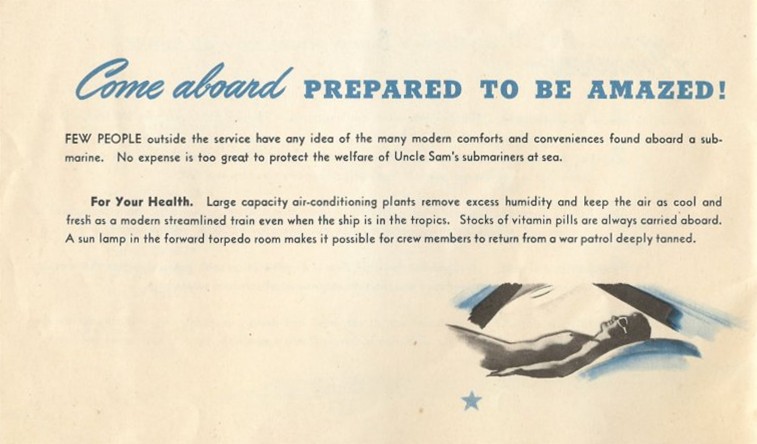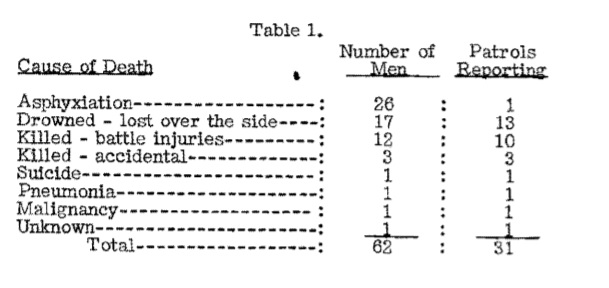
You know, I want to make a joke about the timing of things, but there’s really no need. Sometimes a subgirl shows up a day after she debuts. Some take years.
Anyways. I’m Pam. We’ve actually met – such as this one here. My niche is medicine. If you pop over to the Pampanito’s website you’ll quickly see why that became a sticking point in my character design, and if you wait a bit you’ll probably hear it from me anyways whenever we finally collate and assemble the book.
Medicine is an interesting topic. Here is where I think the modern day abstraction of “healing” or “health points” (is that what you call them) is not inaccurate. The primary purpose of medicine in the military is to maintain the fighting capabilities of the men by making sure they’re healthy. You care for the sick and the injured. In that regard, yes, if there is such a thing as a magical “med-gun” or whatever have you, that would be great! I’d love to use that instead of practicing medicine!
The submarine officer, however, has to do a bit more than that. Let’s think about a few of these as we go on. So, Tautog? Let’s go tell the reader what you’ve learned so far.

Okay! Yay, sub corner.
This is a page from a submarine recruitment advertisement. Read it carefully and keep the simplicity of the message in mind as we proceed.
In general, you can think of medical practice as having several components. There is medicine practiced while aboard a mission or underway, and then there is military medicine practiced in safer areas – such as a submarine base. Most people’s impression of what medicine is is the former. I’m going to touch a bit on the latter before going into more details.
During World War II, medical personnel was in relative short supply. For the submarine, it was even shorter. A submarine medical officer need to not only do all the things the “regular” medical officer does, but he also must know how a submarine works, how matters pertaining to underwater or undersea activities pertain to human health, and for the submarine in particular, the beginnings to understanding psychology. The submarine is a uniquely enclosed space, and if you’re interested, I am definitely happy to talk more about it.
Anyways, basically, at the beginning, there were very few submarine medical officers. Only three medical officers trained out of the Submarine school in a single class, 1933. The Navy did realize this shortage and put forth a training program in 1943, but the numbers are still quite small relative to the needs of the force itself. The actual medical programs did not fully go underway until around 1943-1944, where each submarine crew would receive a comprehensive health evaluation and check-up before and after each of their missions.
This is not to say that the submariners went without medical care. Far from it! Let’s look at some statistics.

From an official US navy report. Out of something like 1520 war patrols involving about 130,000 men, only 62 men lost their lives on a submarine as a result of illness. 26 of these men died in a single incident on the USS Bass, when a fire occurred.
So, if you think about it, the submarine force was really a pretty elite (healthy) group, no? The vast, vast majority of the crew, even if sick, manages to survive into port where they can get proper medical treatment.
A lot of this has the ship’s pharmacist’s mate to thank for. This man is a hospital corpsman, trained up to standard, wand also a submariner. Prior to the V-class submarines such as Bass and Bonita, submarine medicine was only practiced ashore. Once the V-class came into play, however, the Navy thought it would be important to have a crew member on board who could take care of health related matters, since the submarines went on longer and longer patrols.
Basically, the pharmacist’s mate is a volunteer taken from the Force directly. He’s sent to the Submarine School. The typical 1943s pharmacist’s mate received 16 weeks of training from Norfolk, the Navy’s main Hospital Corps school, and then he’s assigned an additional 8 weeks of training at the sub school in New London before sent on a submarine. Sometimes he might even apply for additional training like radar or sonar.
What’s more, just because he finished school doesn’t mean he’s actually “Qualified.” In general, not only does he have to know every part of a submarine, but he must have served for at least six month to a year (or sometimes, two war patrols during war) and performed to his commander’s satisfaction. So, as you can see, the pharmacist’s mate is really a specialized role. He’s got an important job and he’s got the qualifications to back it up. Having a good one of these is almost as important as having a well-like cook in my opinion.
Now, on board the submarine itself, the supplies tend to be somewhat variable. As the pharmacist’s mate is responsible for taking care of the sick and injured, you can expect to see a fairly good range of stuff available just like the average US soldier would receive during the war. Compared to the other military forces, America’s access to medicine was excellent. In general, even aboard a sub, the pharmacist’s mates can generally be expected to find stuff like nikethamide, caffeine or epinephrine (stimulant), quinine (anti-malaria), calamine lotions (for sunburns and stuff like that), and all sorts of antibiotics, even if it’s in a very small relative quantity due to the limited spaces on a submarine. You’re also going to find plenty of things like gauge or wire for surgery, because while not explicitly trained in every surgical method, again surgeries did happen.
(Oh, also. It’s sort of considered to be standard equipment to have stuff like brandy or strong liquor as well. Normally the crew wouldn’t dare to think to break into the medical stores and would resort to moonshining, but, you know, just so you know it’s definitely carried!)
So, just how good were the pharmacist’s mates at their jobs? Well, if the above statistics weren’t convincing enough, let’s use another metric. Downed pilots.
Based on U.S. navy records, American submarines picked up 542 Allied airmen that were shot down. Out of this group, 259 required medical care due to shock, exhaustion, and so on. More than 10 percent had “severe wounds.”
Guess how many died while aboard submarines?
2.
Less than 1% of those who are injured, and about half a percent out of people in total.
See, a lot of people focus on the Pampanito’s rescue of all those POWs, or the Seadragon’s legendary surgery beneath the seas. But, if you look at the stats, it’s really impressive, isn’t it?
I’m going to leave you with a few logs from actual log reports that Pam dug out so you can get an idea of what they did.
This woman had a piece of shrapnel at the bottom of her breast; there was a wound about three inches long and about two inches deep. First I stopped the bleeding. Then I cleaned it thoroughly with alcohol and put sulfanilamide powder in the wound. Then I put in 14 stitches and applied sterile dressings.
(This woman ended up fine – with no infection to the wound too! It’s very impressive for those days)
The medical department in the person of the Chief Pharmacist’s Mate did a particularly capable job in handling the Jap prisoner of war recovered after his plane was shot down. Though suffering from shock, second degree burns of the face and hands and several other serious wounds from gun-shot and the crash, he was brought around very well and will probably arrive in port almost fully recovered.
(Which he did)
Ether was administered, following the directions on the can. This anesthetized the operating staff as well as the patient. One after after completion (the operation lasted about four hours) we tangled with a destroyer. The patient convalesced the following morning — to the tune of torpedo firing, two depth charge attacks, two ‘crash dives’ and an aerial bombing, which knocked him out of his bunk.
(This is the USS Silversides. The patient survived and was commended for his exemplary conduct during the operation and after.)
Pretty fun stuff, right? See you next time. 🙂
